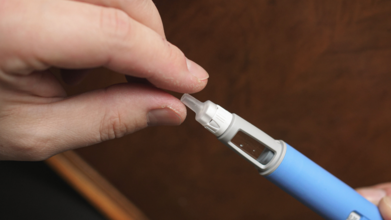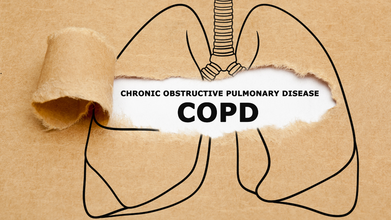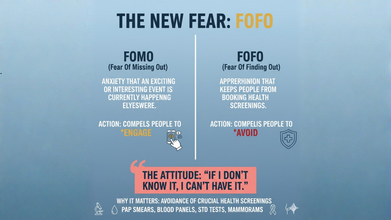- Health Conditions A-Z
- Health & Wellness
- Nutrition
- Fitness
- Health News
- Ayurveda
- Videos
- Medicine A-Z
- Parenting
Ozempic Users Found To Age Back By More Than 3 Years, Finds New Trial; Peer Review Pending

(Credit-Canva)
Scientists have found new evidence suggesting that drugs like Ozempic might have an unexpected benefit: they could help reverse aging. Ozempic has gained a lot of popularity recently. Many celebrities have opened up about using it like Oprah, Meghan Trainor, Elon Musk etc. As more people are using it throughout the world, researchers are studying different effects of it. As the drug is still relatively new, we have heard of Ozempic feet, face, smell etc., researchers have found many different effects these weight loss drugs can have on the human body, however this is a new effect that could change the way we view the phrase 'anti-aging'.
A recent study found that the drug semaglutide, which is in Ozempic and Wegovy, made a person's body biologically younger by an average of about three years.
Also Read: Is Yerba Mate Nature's Answer To Ozempic? Risks And Benefits
This research is still new and hasn't been fully reviewed by other scientists, but it points to a future where these drugs could do more than just treat diabetes and help with weight loss.
What Is Biological Age?
To understand the study, you need to know the difference between your chronological age (how many years you've been alive) and your biological age (how old your body is on the inside). Scientists can measure your biological age by looking at certain chemical changes in your DNA.
For this study, researchers at the TruDiagnostic aging lab in Kentucky measured the biological age of 184 people with a condition linked to rapid aging. They gave a weekly shot of semaglutide to a group of people with a health condition that causes them to age faster. A second group received a placebo shot.
Also Read: Why Ozempic Might Be Making Your Favorite Foods Taste Gross?
How Many Years Does Ozempic Age Us Back?
After 32 weeks, the results were significant:
- The group that took semaglutide saw their biological age go down by an average of 3.1 years.
- The drug also seemed to slow down the aging process in important organs like the brain, heart, and kidneys. In some people, their brain's biological age even appeared to be five years younger.
The study suggests that the drug's ability to improve a person's metabolism and fat distribution might be the reason for these anti-aging effects. While it's too early to use these drugs specifically for anti-aging, these findings are an important first step.
While the study was done on people with a specific health condition, the lead researcher believes the benefits could apply to a wider population. Although it's too early to start using these drugs just for anti-aging, the findings are exciting and point to a potential future where drugs like Ozempic could do more than just treat diabetes and obesity.
This research provides the first real evidence from a clinical trial that semaglutide can actually change the biological signs of aging. It suggests that drugs like Ozempic could be used in the future not just for weight loss and diabetes, but also to help people live longer, healthier lives.
More research is needed, but these findings are a big step forward in understanding the full potential of these drugs. As this research moves forward to be peer-reviewed, one must know what the side-effects of the medicine are.
Side-Effects of Ozempic
Diabetes UK explains that all medications, Ozempic can cause side effects. The most common ones include:
- Nausea
- Diarrhea
- Vomiting
- Risk of worsening eye disease
- Risk of low blood sugar (hypoglycemia)
- Risk of high blood sugar (hyperglycemia)
Not everyone who takes Ozempic will experience these side effects. The likelihood of having them can vary, so it's important to discuss the potential risks with your healthcare provider.
Risks of Ozempic to Watch For
There are a few more serious side effects to be aware of, especially if you have other health conditions:
Risk of Worsening Diabetic Eye Disease (Retinopathy)
If you have diabetic eye disease and also use insulin, there is a risk that your condition could get worse when you start taking Ozempic. This is thought to be caused by a rapid drop in blood sugar. It's crucial to tell your doctor if you have this eye condition or if you notice any changes in your vision after starting Ozempic.
Risk of Low Blood Sugar
When taken alone, Ozempic doesn't usually cause low blood sugar. However, the risk increases if you take it along with other diabetes medications, such as insulin or a sulphonylurea. Your doctor may need to adjust the dose of these other medications to help prevent this from happening.
Also Read: Ozempic Came From A Monster’s Venom-The Creature That Made Weight Loss A Trend
Risk of High Blood Sugar
If you take Ozempic with insulin and your insulin dose is reduced too quickly, it can cause high blood sugar levels. This can lead to a serious condition called diabetic ketoacidosis (DKA). Your healthcare team should explain the signs and symptoms of DKA to you.
Taking Magnesium And Melatonin Together? Here’s How It Affects Your Sleep

Credits: Canva
Magnesium and melatonin are both popular supplements, especially among people looking to get more shuteye, but can combining them improve your sleep? Some research indicates that taking magnesium and melatonin together could improve sleep quality, though stronger, larger studies are needed to confirm the effect.
Can We Combine Magnesium and Melatonin To Support Sleep?
Studies on using magnesium and melatonin together are limited, but some evidence suggests it could benefit sleep in certain individuals.
As per Health, one study focusing on women with polycystic ovary syndrome found that taking both magnesium and melatonin improved sleep quality. Another study reported that people with sleep difficulties who used a combined magnesium-melatonin supplement for four weeks noticed modest improvements in how well they slept.
The exact reason why the two work together is not completely understood, but magnesium and melatonin may influence each other in a way that supports sleep.
“Magnesium does have an effect on melatonin levels,” said Marie van der Merwe, PhD, coordinator of the applied physiology and nutrition doctoral program at the University of Memphis, speaking to Health. “The amount of magnesium you have can influence how well your body produces melatonin.”
You don’t necessarily need to take the two supplements at the same time to benefit, van der Merwe noted. It’s fine to take magnesium in the morning and melatonin before bed.
The takeaway: There could be a link between magnesium and better sleep, but more research is needed to be sure.
Magnesium And Sleep
Magnesium is a vital mineral that supports nerve and muscle function, regulates blood pressure and blood sugar, and contributes to the formation of bone, protein, and DNA. As per Mayo Clinic, it is also commonly taken to help with sleep, but it is not without risks.
Benefits of Magnesium for Sleep
Some studies suggest magnesium may help sleep by:
Improving sleep quality: Ensuring adequate magnesium through diet or supplements may help people with deficiencies sleep better and ease anxiety.
Reducing muscle tension: Magnesium can help relax muscles and relieve tension, which can make it easier to fall asleep.
Risks of Magnesium for Sleep
Research on magnesium for sleep is limited. Supplements aren’t regulated by the FDA for safety or effectiveness and carry potential risks:
Delayed effect: It may take several weeks before magnesium supplements noticeably improve sleep.5
Side effects: High doses can cause diarrhea, nausea, and stomach cramps.7
Drug interactions: Magnesium can interfere with some medications, reducing their effect or increasing side effects. Talk to a doctor before starting any new supplement.7
Melatonin And Sleep
Melatonin is a well-known sleep aid, though it’s actually a hormone your body naturally produces to regulate sleep-wake cycles.⁸ “Melatonin is in charge of running the [internal] clock, and it really is important for regulating your circadian rhythms,” van der Merwe said.
Benefits of Melatonin for Sleep
Works quickly when needed: Unlike magnesium, melatonin can act soon after taking it, making it useful for occasional sleepless nights.
May help you fall asleep faster: Studies show that a 2-milligram dose of melatonin helped some people fall asleep about nine minutes sooner than placebo.
Supports sleep timing: Melatonin can help shift workers, travelers with jet lag, or those with irregular sleep schedules align their sleep patterns.
Risks Of Melatonin For Sleep
Melatonin can help with some sleep difficulties but won’t fix all sleep disorders, van der Merwe said. Like magnesium, melatonin isn’t FDA-regulated:
Long-term effects unclear: There’s limited data on the safety of long-term melatonin use.
Medication interactions: Melatonin may interact with antibiotics, antidepressants, and birth control.
Caution for certain groups: It’s generally not recommended for children or people with dementia, and should be used carefully by those with seizures or on blood thinners.
What to Consider Before Taking Magnesium and Melatonin Together?
It’s wise to speak with a healthcare professional before starting any new supplements, alone or in combination.
Van der Merwe emphasized that sleep problems can stem from issues that supplements alone won’t fix. Conditions like cardiovascular disease, type 2 diabetes, and depression can affect sleep.
If you want to try one or both supplements, a doctor can help determine the best timing for magnesium, melatonin, or a combined product.
“Melatonin [should] increase at night,” van der Merwe explained, so it is crucial to take it at the right time. Taking it in the morning can disrupt your internal clock.
Even though sleep-support supplements like magnesium and melatonin have grown in popularity, it’s important to consult a professional to see if they will help in your situation.
Why COPD Is Now Affecting People in Their 20s and 30s

Credits: Canva
Chronic obstructive pulmonary disease (COPD) has long been seen as a condition of older adults, typically tied to years of smoking. But across India, pulmonologists are increasingly diagnosing it in people in their 20s and 30s. This shift, experts say, reflects a deeper and more troubling change: young adults are growing up and living in environments where the lungs never truly get a chance to breathe clean air.
A Shift From “Smoker’s Disease” to “Exposure Disease”
The biggest change is the cause itself. As Dr. Raja Dhar, Director & HOD, Pulmonology, CK Birla Hospitals, CMRI Kolkata, explains, “COPD is increasingly becoming an ‘exposure disease’ rather than a ‘smoker’s disease.’ In India, non-smoking COPD is numerically a much larger problem.”
This exposure begins early—sometimes in childhood.
Dr. Dhar highlights how even limited exposure can have lifelong consequences: “Severe airway obstruction can be traced back to just six to seven years of biomass smoke exposure in a poorly ventilated kitchen during a child’s formative years.”
Dr. Harshil Alwani, Consultant – Pulmonology, CK Birla Hospitals, Jaipur, also points to the changing risk profile. According to him, “newer epidemiological data show that non-smoking drivers—especially air pollution and occupational exposures—are playing a disproportionately large role in younger people.” He adds that rapid urbanisation means more young adults are chronically breathing polluted air from childhood onwards.
Improved diagnosis and greater awareness also mean younger patients with persistent symptoms are now being evaluated more often, he notes.
Beyond Smoking: The Real Culprits Behind Early COPD
Air Pollution
Both experts agree that polluted air is the biggest trigger today. Dr. Alwani explains that long-term exposure to PM₂.₅ is directly linked to lung decline and COPD. “Recent research shows that temperature and humidity modulate the harmful effect of PM₂.₅, making COPD risk worse under certain climatic conditions,” he says.
Dr. Dhar adds that India’s air quality is deteriorating nationwide: “Ambient outdoor air pollution is a severe risk, as air quality across 98% of India is worse than WHO standards.”
Indoor Pollution
Household pollution remains a massive issue. Biomass fuel used for cooking is, as Dr. Dhar puts it, “the largest non-smoking contributor, resulting in numbers approximately three times that of smoking-related COPD.”
Occupational Hazards
Young adults working in construction, mining, welding, or factory settings face daily exposure to dust, fumes, and chemicals. Dr. Alwani notes that such environments “carry a significantly increased risk.”
Childhood Lung Infections
Recurrent infections can impair lung development and reduce lung reserve, making early-onset disease more likely.
Genetic Factors
Conditions like alpha-1 antitrypsin deficiency, though rare, still contribute when combined with environmental triggers.
Delhi’s Winter Pollution: A Direct Route to Lung Damage
Every winter, Delhi’s smog becomes a health emergency. According to Dr. Dhar, “High winter pollution, particularly hazardous levels of PM2.5, acts as a chronic, low-grade chemical burn on the young respiratory system.”
Dr. Alwani adds that winter inversion traps pollutants closer to the ground, amplifying PM₂.₅’s damage.
The Vaping Problem
Vaping and e-cigarettes, widely perceived as harmless, have added a new layer of risk. Dr. Alwani warns, “Vaping is not benign. Its aerosols contain volatile compounds, heavy metals, and ultrafine particles that trigger inflammation and oxidative stress—central pathways to COPD.”
Dr. Dhar echoes this concern: “Any inhalation of heated chemical aerosols is a significant lung irritant and pro-inflammatory agent.”
Symptoms Young Adults Should Never Ignore
Doctors urge young adults not to dismiss symptoms like:
- Persistent cough
- Breathlessness during routine activity
- Wheezing or chest tightness
- Frequent colds or bronchitis
- Fatigue or reduced stamina
Why Early Diagnosis Matters
Early spirometry can dramatically change outcomes. As Dr. Dhar puts it, “Early intervention allows us to remove the source of exposure and start therapy, which can effectively preserve the patient’s remaining lung function.”
Dr. Alwani adds that catching the disease early can “significantly slow further lung damage” and prevent long-term complications.
FOFO (Not FOMO) Is The New Psychological Barrier That’s Fueling a Drop In Health Screenings

Credits: AI-generated
We all know the feeling of FOMO, the fear of missing out, but there exist another fear, this is FOFO: the fear of finding out. This apprehension is what keeps people from boking their health screenings. The horrors of what will happen after a mammogram, a Pap smear, an STD test, blood panel, or even something as simple as a blood pressure check can scare those with FOFO.
While the term itself is not a medical diagnosis, it is a widely recognized behavioral pattern that both patients and doctors get to see frequently. Over the years, it has gained more attention among experts who deal with health anxiety. As one clinical psychologist explains, there isn’t much published research on FOFO, but practitioners who work with health-related anxiety are very familiar with its impact.
What is even worrying is how common this avoidance has become. As per a 2025 survey of 2,000 employed US adults, 3 out 5 avoid medical screenings altogether, due to fear of bad news or embarrassment. Another 2025 reveal that of 7,000 adults, only 51% attended a routine medical appointment of cancer screening, with a 10% drop from 2024.
The attitude is: "If I don't know it, I can't have it".
Where Does FOFO Come From?
According to psychologists, FOFO often roots itself in anxiety and the desire for control. When something feels uncertain—like a health test result—many people instinctively avoid it. Avoidance becomes a way to quiet the anxiety, at least temporarily.
Experts say FOFO is especially common in people with generalized anxiety disorder, OCD, or illness anxiety disorder. But anyone can experience it. For some, it’s a one-off situation—like hesitating over a prostate exam. For others, it’s part of a broader coping style that involves avoiding anything that feels threatening. Ironically, this sometimes goes hand in hand with endlessly checking symptoms online.
Previous negative experiences in healthcare settings can also feed FOFO. Some people feel anxious around doctors or medical procedures, while others fear being judged, especially when a screening could uncover conditions that carry social stigma—such as STDs. There’s also the fear of receiving results that might force lifestyle changes or treatments they’re not ready for.
A common unspoken belief behind FOFO is:
“If I don’t take the test, then the problem doesn’t exist.”
Waiting for test results adds to the anxiety too. When results take days or weeks, the uncertainty can feel more stressful than the test itself.
How Can You Break The FOFO Cycle?
The first step is by acknowledging what is at stake. Many experts recommend weighing the pros and cons of taking the test versus avoiding it. If FOFO is holding you back, ask yourself what exactly you’re afraid of. Many people underestimate their ability to handle bad news. Understanding this can help reduce the emotional weight of screening.
It’s also helpful to reflect on a few important questions:
- Do I want fear to dictate my health choices?
- What could happen if I keep putting this off?
- A year from now, will I regret not acting today?
These questions often shift the focus from fear to long-term wellbeing. As psychologists note, facing the fear usually leads to decisions that better align with your values.
© 2024 Bennett, Coleman & Company Limited

